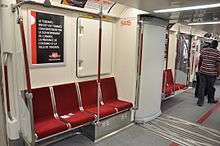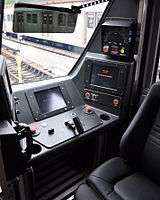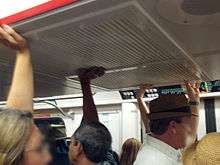Toronto Rocket
| Toronto Rocket | |
|---|---|
|
Toronto Rocket subway train at Rosedale Station | |
|
View along full length of train | |
| In service | 2011–present |
| Manufacturer | Bombardier Transportation |
| Built at | Thunder Bay, Ontario |
| Family name | Movia |
| Replaced | H4, H5, H6 |
| Constructed | 2008–present |
| Number under construction | 80 six-car trains on order[1][2][3] |
| Formation | 6-car set (Line 1), 4-car set (Line 4) |
| Fleet numbers | 5381-6176[4] |
| Capacity |
64–68 (seated/per car) 1458 (full train, crush load)[5] |
| Operator(s) | Toronto Transit Commission |
| Depot(s) |
Wilson Subway Yard Davisville Subway Yard |
| Line(s) served |
|
| Specifications | |
| Car body construction | stainless steel[6] |
| Car length | 23.190 m (76.08 ft) [4] |
| Height | 3.137 m (10.29 ft)[4] |
| Doors | 8 sets (4 sets per side) per car |
| Maximum speed | 88 km/h (55 mph)[4] |
| Weight | 205,000 kg (202 long tons; 226 short tons) (per trainset); 34,167 kg (33.627 long tons; 37.663 short tons) per car[4] |
| Traction motors | Bombardier MITRAC three phase AC |
| Power output |
155 kW (207.858 hp) per motor 3,100 kW (4,157.168 hp) per 6-car train |
| Acceleration | 0.90 m/s2 (3.0 ft/s2) (limited) |
| Deceleration |
1.35 m/s2 (4.4 ft/s2) (Service), 1.5 m/s2 (4.9 ft/s2) (Emergency) |
| Auxiliaries | 120/208 V AC Battery Auxiliary |
| Electric system(s) | 600 V DC (third rail) |
| Current collection method | Contact shoe |
| Braking system(s) | Regenerative and Pneumatic |
| Safety system(s) | Emergency evacuation ramps at each end of trainset |
| Track gauge | 4 ft 10 7⁄8 in (1,495 mm) |
The Toronto Rocket (TR) is the latest model in the rolling stock of passenger trains used on the Toronto subway system. Owned and operated by the Toronto Transit Commission (TTC), the trains were built by Bombardier Transportation in Thunder Bay, Ontario, Canada with designs based on the Movia family of trains. They are the first rapid transit trains in North America that feature open gangways, allowing passengers to walk through the entire length of the train and increasing capacity by 10%.
The TR trains replaced the last remaining H-series trains in 2014. The trains operate in a six-car configuration on Line 1 Yonge–University and four-car configuration on Line 4 Sheppard.
Name
The trains were designated under the production name as T35A08 before the name "Toronto Rocket" was chosen through a contest open to the public.[7][8]
Delivery
Delivery of the TR trains was expected to begin in late 2009, and they were scheduled to enter passenger service in early 2010. However, delivery was delayed by the bankruptcy of a key part manufacturer, Curtis Doors, which was to install door components for the TTC's TR subway trains.[4][9][10]
The initial order was signed in 2006 for the delivery of 234 cars, making 39 six-car fixed trains which allowed for the retirement of the H4 and H5 subway cars.
On May 6, 2010, the TTC voted to exercise a contract option with Bombardier for an additional 186 cars, making 31 six-car fixed train sets. This allowed for the retirement of the older H6 series trains, and to have enough TR trains to meet future ridership demands for the opening of the Spadina Subway extension to the Vaughan Metropolitan Centre, which was then scheduled for opening in mid-2015 (in time for the opening of that summer's Pan Am Games).[2][11] However, the opening of the extension has since been delayed until approximately December 2017.[12]
A further 10 train sets (60 cars) were authorized in March 2014 to bring the total to 80 six-car train sets and 480 cars.[3] In March 2015, the TTC reported that the T1 trains running on Line 4 would have to be replaced with TR trains before conversion of Line 1 to automatic train control (ATC) in 2020, and that TTC would report soon on the option of converting an existing six-car train to a four-car train to test One Person Only Train Operation (OPOTO) (a system that is already in place on Line 3 Scarborough).[13]
These four-car TR trains entered service on Line 4 on May 30, 2016 with two crew members.[14] On October 9, 2016, One person only train operation was introduced on that line.
On October 1, 2010, the first train set (5391-5396) was delivered to Wilson Yard. It was unveiled to the public and media at Downsview station on October 14, 2010.[15]
Between October 2010 and July 2011, the TR trains underwent a series of testing and training runs on Line 1. The first TR trainset (5411-5416) entered passenger service on Line 1 on July 21, 2011. In the summer of 2016, some TR trains were used on Line 2 to address the shortage of T1s caused by faulty air-conditioners. Regular use of TR trains on Line 2 is planned for 2025-2026.[16]
Features
The new TR series trains have several new features that make them more accessible and user-friendly for passengers including:
- A six-car-fixed configuration with full open interior gangways, allowing riders to move freely from one end to the other.
- An exterior blue light on each car leading to the nearest accessible seating area for passengers using mobility devices.
- Red stanchions and high visibility floor markings to assist visually impaired passengers.
- Antimicrobial properties on various surfaces.
- Doubled number of accessible seats in each car than the T1 series subway cars, with automatic flip-up seats, which mark priority seating areas to accommodate mobility devices such as walkers, wheelchairs, bicycles and strollers. As with all TTC vehicles, priority seats are covered in blue velour; general seating is covered in red velour.
- Automated stop announcement system with audio and visual digital orange LED signs that indicate the name of the next stop, and if the station is an interchange or terminal station; along with visual arrows that indicate which side doors will open on at the next stop as well as audio announcements (based on direction of train travel) indicating on which side of the train doors will open on (except for terminal stations) to assist visually impaired passengers.
- Electronic LED route maps that indicate which stations have been served (in green dots) and which stations are next to follow (in red dots) (interchange stations are lit in yellow dots).
- A two-way passenger assistance intercom system for passengers to communicate with the train crew in the event of an emergency.
- Built-in evacuation ramps located at the ends of the train to allow for faster and easier evacuation in the event of an emergency.
- Full-width operator cabs located at the ends of the train for the enhanced safety and security of operating personnel (as operators are able to access the cab unit directly from the subway platform and are not exposed to the public while performing operating duties).
- Bright orange digital LED exterior destination and train run number signs (which show three digits) at the ends of the train.
- Ceiling-mounted CCTV cameras with four in each car for passenger safety and security. Footage is recorded and can be reviewed in the event of an incident.
- Video screens displaying safety messages, TTC-related advertising and the name of the next station at the bottom.
- As of October 2016, some TR trains now have LED boards displaying the line on the sides and an audible external announcement announcing the line number and the destination.
Retrofits
In February 2013, the TTC began a trial phase with the installation of external door chimes (on each set of doorways) and additional yellow plastic straps (placed underneath the HVAC units) on the TR trains. Set 5461-5466 was the first to be retrofitted, followed by set 5851-5856 in May 2014. The rest of the TR trains fleet has the door chimes played inside the train via the public address system. The retrofitted trains have a lower pitched three-tone warning chime (F♯, D♯, B). The other TR trains have a higher pitched three-tone warning chime (G, E, C). Yellow plastic straps have been phased in on all TR trains in late 2015. It has been reported that all TR trains will be retrofitted with external door chimes by approximately late 2016.[6][17][18][19][20]
 Gangway between cars. The poster, in French, when translated into English, reads "The Toronto Rocket is jointly financed by the Government of Canada, the Province of Ontario, and the City of Toronto."
Gangway between cars. The poster, in French, when translated into English, reads "The Toronto Rocket is jointly financed by the Government of Canada, the Province of Ontario, and the City of Toronto." Exterior view of the gangway
Exterior view of the gangway- Side view of cab car, seen at Wilson Yard
 Operator's cab
Operator's cab Folding seats in wheelchair accessible position
Folding seats in wheelchair accessible position Front view at St. George station
Front view at St. George station
Financing
The TR trains are funded by the City of Toronto (via Toronto Transportation Services), the Province of Ontario (via the Ministry of Transportation), and the Government of Canada (via Transport Canada).
Interior design
The interior scheme on the TR trains is similar to the previous model, the T1 series. Unlike the older versions of subway cars, they have full-open interior gangways. The colour scheme consists of white cream walls, stainless steel doorways, and grey floors with red floor markings for visually impaired passengers.
Rolling stock numbers
The TR train sets are numbered 5381-6176.[1] Each set is numbered xxx1-xxx6; car numbers ending in 0, 7, 8 and 9 are not used. These are the first trains to adopt numbering in the 6000s, since the TRs are a full-open trainset with no separators between cars (unlike previous models, which are formed in married pairs). Sets are numbered, for example, 5381-5382-5383-5384-5385-5386 in the case of six-car trainsets and/or 6141-6142-6145-6146 in the case of four-car trainsets and so on. (At one point, two train sets had their numbers temporarily exchanged. These included sets 5781-5786 in which the exterior bore the number 5803, while train set 5801-5806 bore 5783 on the exterior car. They have since been resolved as 5803 on 5781-5786 was renumbered as 5783, and train set 5801-5806, which bore 5783, was renumbered as 5803).
Criticism
Tendering process
During the tendering process, Siemens Canada (see Siemens Modular Metro) was seen a possible competitor to the Bombardier bid.[21][22] Councillors Karen Stintz (who later also served as TTC chair), Denzil Minnan-Wong, and Rob Ford (who became mayor in late 2010) were opposed to sole-sourcing the contract to Bombardier. They alleged that many sole-source advocates had union ties and were thus not interested in getting the best financial deal available to the city.[23]
Mobility issues

In late September 2011, it was reported that some passengers with mobility devices were experiencing difficulties while entering and/or exiting the then-new TR trains. TTC officials noted that this could either be because the train was sitting too high in relation to the level of the platform or be the result of the train’s door threshold, which is not parallel with the platform and/or the number of passengers riding on the train. They were actively looking for ways to solve the problem.[24]
To increase mobility, the train does not have centre poles, leaving standing riders with fewer places to hold onto. There are swinging handles hanging from a lateral pole along the length of each car near the ceiling, except near car ends, where an overhead ventilation unit is located.[25]
"Teething issues"
In March 2012, TTC officials admitted that the door threshold incidents were the result of “teething issues”. Another issue that was acknowledged involves a short delay in opening of the doors when the train pulls into a station. On the older train models, the door release interlock could be triggered just before or immediately after the vehicle came to a complete stop. The TR trains must come to a complete stop with confirmation from the onboard computer before the door interlock can be released and the guard can open the doors. This causes a one- or two-second delay from the time the train appears stopped and the time the doors open.[26]
In December 2012, the TTC announced that it had demanded high-level meeting with Bombardier regarding ongoing performance problems related to "teething issues" with the doors. TTC officials admitted at the time that the new TR trains cannot move until all doors are fully closed (as with the older trains) and if the doors fail to close thrice in a row fully, the TR train would require a system reboot, meaning that the train will have to be pulled out of service until it is resolved. This has led to several delays on the Yonge–University line.[27]
Increased brightness
The TR trains feature a significantly brighter interior than previous models, which some passengers find distracting.[28][29]
See also
References
- 1 2 Toronto Transit Commission (March 6, 2015). "TTC Service Summary - March 29,2015 to May 9, 2015" (PDF). Retrieved 2015-03-22.
- 1 2 "TTC approves 186 more subway cars". TBNewsWatch.com. 2010-05-06. Retrieved 2012-12-05.
- 1 2 "Procurement Authorization Amendment to Purchase 10 Additional Toronto Rocket Train Sets - Purchase Order No. C31PD05761" (PDF). Toronto Transit Commission. 2015-03-26. Retrieved 2015-03-22.
- 1 2 3 4 5 6 "New Subway Train - The Toronto Rocket". Toronto Transit Commission. May 2011. Retrieved 2012-12-05.
- ↑ Bombardier. "Technical data - Metro Subway Train "Toronto Rocket" – Toronto, Canada". Bombardier Transportation. Retrieved 2016-09-04.
- 1 2 "Toronto Rocket Subway Train - Toronto, Canada (Project Overview)". Bombardier Transportation. Retrieved 2012-12-05.
- ↑ Bow, James (2012-04-21). "The Toronto Rocket Cars (T35A08)". transit.toronto.on.ca. Retrieved 2012-12-05.
- ↑ ""Toronto Rocket" A Train with a new Name". Marketwired. 2006-10-13. Retrieved 2012-12-05.
- ↑ Natalie Alcoba (2010-01-14). "New TTC trains delayed after door company goes belly up". National Post. Retrieved 2010-01-15.
- ↑ Bow, James (2009-09-22). "TTC Looking For New Subway Cars in October". transit.toronto.on.ca. Retrieved 2012-12-05.
- ↑ "Procurement Authorization Amendment - option to purchase 31 additional new subway train sets (for H6 subway car replacement and TYSSE)" (PDF). Toronto Transit Commission. 2010-05-06. Retrieved 2012-12-05.
- ↑ "Toronto-York Spadina Subway Extension – Schedule and Budget Change" (PDF). Toronto Transit Commission. 2015-03-26. Retrieved 2015-03-23.
- ↑ "Procurement Authorization - Procurement Authorization Change Directive to the Toronto Rocket (TR) Supplier for the Design Provisions for Train Door Monitoring (TDM) System" (PDF). Toronto Transit Commission. 2015-03-26. Retrieved 2015-03-22.
- ↑ http://www.cbc.ca/news/canada/toronto/sheppard-subway-line-gets-new-toronto-rocket-trains-1.3607811
- ↑ "TTC unveils new subway cars". CP24. 2010-10-14. Retrieved 2012-12-05. [ TTC unveils new subway cars] CP24, published on October 14, 2010
- ↑ http://www.cbc.ca/news/canada/toronto/ttc-hot-subway-cars-air-conditioning-1.3655494
- ↑ TTC set to fix most annoying feature of Rocket trains | BlogTO. blogto.com. Retrieved on 2015-01-13.
- ↑ "Toronto Rocket: Overview and Key Features". Toronto Transit Commission. 2008. Retrieved 2012-12-05.
- ↑ TTC tweaks its new Rocket trains
- ↑ Oakland, Ross (2012-04-20). "New TTC train, the Rocket, takes away some of the 'fun factor'". Toronto: Toronto Star. Retrieved 2012-12-05.
- ↑ "TTC approves Bombardier deal". CBC News. 2006-08-31. Retrieved 2012-12-05. CBC News
- ↑ Kalinowski, Tess (2009-04-18). "A streetcar now for city of tomorrow". Toronto: Toronto Star. Retrieved 2012-12-05.
- ↑ "Made in Canada Matters! - Why the City of Toronto Should Purchase 'Made In Canada' Products" (PDF). Toronto & York Region Labour Council. 2006-10-03. Retrieved 2012-12-05.
- ↑ Kalinowski, Tess (2011-09-25). "Wheelchair users can't always roll onto the Rocket". Toronto Star. Retrieved 2012-12-05.
- ↑ Matt Gurney: Fixing the doors on new TTC’s subway cars an opportunity to change other things as well | National Post. News.nationalpost.com. Retrieved on 2013-07-26.
- ↑ Kalinowski, Tess (2012-03-30). "TTC working out bugs on new subway trains". Toronto Star. Retrieved 2012-12-05.
- ↑ Grewal, San (2012-12-04). "Toronto's new Rocket subway trains malfunctioning". Toronto Star. Retrieved 2012-12-05.
- ↑ TTC launches brighter, more open subway cars | Toronto Star. Thestar.com (2010-10-15). Retrieved on 2013-07-26.
- ↑ What should the TTC do to improve its Rocket trains?. Blogto.com (2012-12-05). Retrieved on 2013-07-26.
External links
![]() Media related to Toronto Rocket at Wikimedia Commons
Media related to Toronto Rocket at Wikimedia Commons
- "New Subway Train - The Toronto Rocket". Toronto Transit Commission. May 2011. Retrieved 2012-12-05.
- "New TTC Subway Cars - Urban Toronto". Forum » Greater Toronto Discussion » Transportation & Infrastructure » New TTC Subway Cars. Urban Toronto. 2006-01-29. Retrieved 2012-12-05.

_(14918534190).jpg)